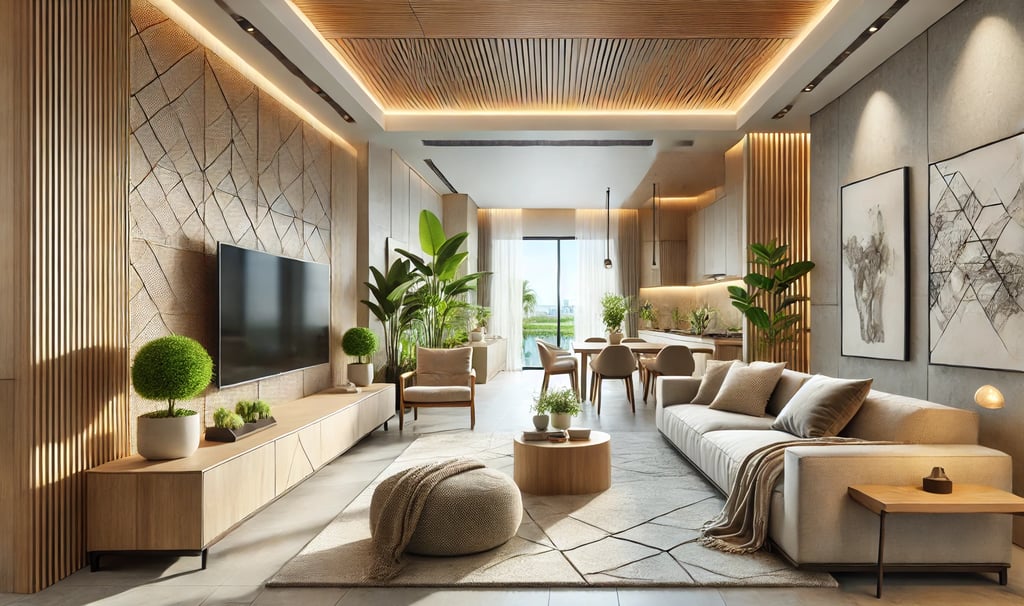Interior Designing and Health
Did you know that your surroundings can influence your physical and mental well-being? Thoughtful interior design goes beyond aesthetics—it plays a vital role in creating healthier, happier spaces. Designing with health in mind isn't just a trend—it's a lifestyle. Discover how simple yet intentional changes can transform your space into a sanctuary for your mind and body.
Sakina Baxa
1/13/20252 min read


The intersection of health and interior design has become a significant focus, as research increasingly shows how our surroundings influence our physical and mental well-being. From residential to commercial spaces, a thoughtfully designed environment can foster better health, productivity, and emotional stability. Here are some of the ways design can promote well-being:
1. Natural Light
Exposure to natural light plays a crucial role in regulating our circadian rhythms, improving mood, and enhancing productivity. Rooms with ample windows or skylights can reduce eye strain, help manage sleep patterns, and even alleviate symptoms of seasonal affective disorder. Designers can prioritize large windows, glass walls, and open layouts to maximize daylight.
2. Indoor Air Quality
Clean air is essential for good health. Materials used in construction, furniture, and decor can sometimes release volatile organic compounds (VOCs), which are linked to respiratory issues and allergies. Health-conscious design incorporates low-VOC paints and finishes, proper ventilation, and indoor plants that naturally purify the air.
3. Biophilic Design
Biophilic design is about integrating nature into interior spaces, which can reduce stress, enhance creativity, and support mental health. Features like indoor gardens, natural materials (such as wood and stone), and water elements create a calming, grounded atmosphere. Studies have shown that incorporating biophilic elements can reduce stress and improve overall mood.
4. Ergonomics and Comfort
Furniture that supports natural body alignment, encourages good posture, and reduces strain can prevent musculoskeletal issues. For example, ergonomic chairs, adjustable desks, and appropriately designed kitchen spaces can support healthier habits. Thoughtful layouts that reduce clutter and provide ample space for movement are also key to promoting physical health.
5. Color Psychology
Color plays a powerful role in how we feel in a space. Warm colors like reds and oranges can energize a room, while cool tones like blues and greens tend to be calming and restorative. Strategic color choices can be used to set moods; for example, soft colors in bedrooms may promote relaxation, while more vibrant hues in communal areas encourage social interaction.
6. Acoustic Comfort
Noise pollution can lead to stress, sleep disturbances, and difficulty concentrating. Good acoustic design—like adding rugs, soft furnishings, and acoustic panels—helps to absorb sound and reduce noise. In workplaces, for instance, controlling noise levels can significantly improve focus and productivity.
7. Lighting Design
In addition to natural light, artificial lighting also impacts health. Adjustable lighting allows for a range of brightness settings, supporting different activities and moods. Blue-rich light is ideal for focused work, while warmer tones can help to create a relaxing ambiance in the evening.
8. Emotional and Social Well-being
Design can encourage social interaction and connection, which are essential for emotional health. Open layouts, communal spaces, and cozy seating arrangements can make people feel more connected. Incorporating elements of personalization—like art, photographs, or cherished objects—can also create a sense of belonging and security.
9. Safe Materials
Health-conscious design prioritizes safe, non-toxic materials. For example, designers can choose hypoallergenic fabrics, sustainable wood, and chemical-free finishes to limit exposure to allergens and toxins. Many sustainable options now available are both stylish and healthy, ensuring aesthetic value without sacrificing well-being.
10. Space for Wellness Activities
Having designated areas for relaxation, exercise, or meditation at home or in workplaces can encourage people to prioritize self-care. Wellness spaces can be outfitted with soft textures, calming colors, and minimalistic decor to help users recharge.
Interior design profoundly affects health, shaping our comfort, productivity, and peace of mind. Thoughtfully designed spaces that prioritize natural elements, safety, and comfort contribute to an environment where people can thrive physically, mentally, and emotionally. By blending functionality with aesthetics, designers can create spaces that truly support holistic well-being.


